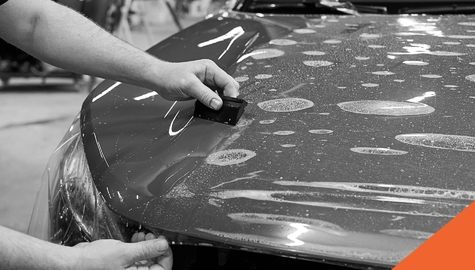My Car is Stuck in Snow - Now What?
Wednesday, 4 January 2023
The first thing to do is assess the situation. Are you stuck in a deep snowbank, or is the snow just packed around your tires? If you're stuck in a deep snowbank, it will be more difficult to get out. You may need to wait for a tow truck or some help from a passersby. There’s nothing like seeing a group of friendly Canadians coming to the rescue of someone stuck in the snow! However, if the snow is only packed around your tires, you might be able to get out on your own.
How to Get Your Car Unstuck from Snow
Vibration Method
Get in your car and turn on the engine. Put the car into drive (or reverse, if you're stuck facing uphill) and gently press the gas pedal, so the wheels start to spin. As they spin, the momentum will help loosen the packed snow and eventually move your car out of the snowbank.
Rocking Method
The rocking method is one of the simpler ways to get unstuck from snow. To begin, shift your vehicle into low gear and let your foot off the brake. Next, gently step on the gas pedal and release it. You should feel your car rock back and forth. Once you've built up enough momentum, carefully turn the steering wheel back and forth until you're able to break free from the snowbank. That's all there is to it! The rocking method is great if you find yourself stuck in a relatively light snowfall.
Using Kitty Litter
If you happen to have kitty litter in your trunk (or even sand or salt), sprinkle it around your tires for extra traction. This will help your tires grip the ground and get out of the snowbank easier.
Push Method
This only works if there's someone else around to help you. One person should get in the car and put it into drive (or reverse), while another person pushes from behind the vehicle. Once you've got enough speed, hopefully, you'll be able to make it out of the bank on your own!
The winch method: If you have a tow truck or another vehicle with a winch, you can attach it to your car and use it to pull yourself out of the bank. Be careful with this one—you don't want to damage your vehicle or injure yourself in the process!
Straighten Your Wheel
Many people don't realize this, but when you're stuck in the snow and trying to get out, the best thing you can do is straighten your steering wheel. This seems counterintuitive, but straightening your steering wheel will give you more traction. When your wheels are turned, they're more likely to spin without getting any traction. But if they're straight, your tires will have a better chance of gripping the ground and getting you out of that pesky snowbank. Next time you find yourself stuck in the snow, remember to straighten your steering wheel before trying to get out. It might just save you some time—and some frustration.
Forward and Back Technique
The forward and back technique is very similar to the rocking method but with a few key differences. For starters, you'll want to put your car into a low gear as before. However, instead of letting your foot off the brake, keep it firmly planted on the pedal while slowly releasing the emergency brake lever. When you're ready, give the gas pedal a little tap so that your car moves forward a few inches before coming to a stop again. Repeat this process until you've gained enough momentum to break free from the snowbank.
While this method may take a bit longer than the rocking method, it's often more successful since it gives you more control over your car's movements.
The Braking Technique
Only attempt the braking method if you find yourself stuck in deep snow or ice—never try it on dry pavement, as it could result in serious damage to your vehicle. To start, shift into a low gear, as usual, then apply light pressure to both pedals simultaneously—the goal here is not to stop, but rather use the brakes lightly while still applying gas so that your wheels can gain traction without spinning out of control. If done correctly, this will help minimize how much your wheels spin and provide much-needed traction for getting unstuck.
Being stuck in a snowbank is never fun, but luckily there are a few things you can do to increase your chances of getting unstuck! Next time you find yourself in this predicament, try one of these techniques and see if it helps. And remember—if all else fails, call for help!
Why Winter Tires are Important
As any Canadian driver knows, winter driving can be a challenge. Ice and snow can make roads slick and dangerous, making it hard to stop or turn quickly if you need to. Winter tires can help avoid getting your car stuck in the snow. They provide extra traction on snow and ice, helping you to stay in control of your vehicle and avoid accidents. Winter tires will not only keep you safe, they also improve your fuel economy by reducing resistance on the road. This means your engine doesn't have to work as hard to move your vehicle forward. In fact, studies have shown that switching to winter tires can improve fuel economy by up to 4%.
How Winter Tires Affect Your Insurance
There's no doubt that winter can be a tough time of year. But with a little preparation, you can make it through without any issues—and maybe even save yourself some money in the process!
In Canada, winter tires are mandatory in some provinces and highly recommended in others. But even if winter tires are not required where you live, they're still a good idea. Winter tires' specific design provides better traction and stability in cold weather and on snowy or icy roads. And when you have better control of your vehicle, that can lead to safer driving—and potential savings on your car insurance premium.
Most insurance companies offer a 2% to 4% discount for drivers who switch to winter tires, so it's definitely worth considering if you haven't already made the switch. And even if your insurance company doesn't offer a discount, there may be other benefits to making the switch. For example, some provinces offer a rebate on the purchase of winter tires, so you could end up saving money in the long run anyway.
You should make the switch to winter tires when the weather is consistently below 7 degrees Celsius. Each insurance company has a range when you are required to install winter tires to get the discount. Time frames vary but are usually somewhere around late October to the end of April. Check with your insurance provider to make sure you hit the deadline! If you’ve already purchased winter tires and are ready to get a discount on your car insurance, let your broker know.
How to Prepare Your Vehicle for Winter
In addition to getting new tires, you can do a few things to prepare you and your vehicle for safe winter driving.
- Have your battery checked. Cold weather puts extra strain on your battery, so it's important to make sure it's in good condition before winter hits.
- Fill up your washer fluid reservoir. You'll be using your windshield wipers a lot more in the winter, so you'll need to make sure you have plenty of washer fluid on hand to keep your windshield clean.
- Pack an emergency kit. This should include items like a flashlight, jumper cables, flares, and a first-aid kit. It's also a good idea to pack some snacks and water in case you get stranded somewhere.
Getting stuck in the snow is no fun, but it can happen to anyone regardless of driving skill. The important thing is not to panic and know what steps to take to get yourself unstuck safely. By following these tips, you'll be back on the road in no time!
At Billyard Insurance Group we are proud to have some of the most competitive rates in the country. If you’re ready to save money on your insurance then get started with a free online quote today!



